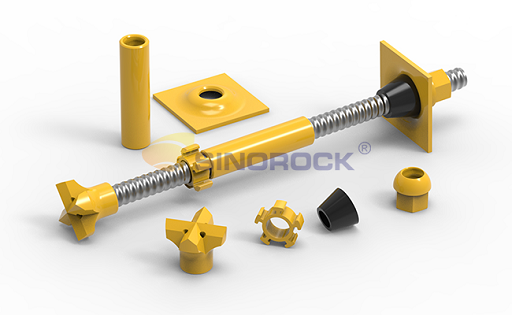Advantages of Self-Drilling Rock Bolts in the Treatment of Disastrous Geological Slopes
Time:2022-08-16From:sinorock View:
With the development of global engineering construction, there are more and more projects such as highways, railways, mines, and water conservancy projects. A large number of slope terrains will inevitably be encountered in the project. Unstable slopes have geological hazards such as collapse and landslides during construction. Therefore, the research, development, and application of slope protection and reinforcement treatment technology have high social significance and economic value.There are various forms of slope protection technology used internationally. Among them, self-drilling hollow bolt support is a safe, high-quality, and efficient protection technology, which has been widely used in various slope protection and reinforcement projects.
Below, we take the slope support project of a nuclear power plant as an example.
The west side slope of the main plant area of the nuclear power plant is a rock slope. Due to the impact of rain erosion and blasting construction, the slope appeared partial collapse and dropped blocks. In order to strengthen the local stability of the slope, the project adopts the support method of plain concrete repair and self-drilling rock bolt anchoring. The engineering design drilling depth is 6 m ~ 12 m. The anchor rods are all 6m long anchor rods, and the lengths are socketed with equal-strength connections.
The mechanical action principle of the self-drilling hollow bolt can be summarized in the following three points:

Suspension of anchor rod: The anchor rod passes through the weak and loose rock and soil mass, and is anchored into the stable stratum to generate tension, overcome the self-weight and sliding force of the sliding rock and soil mass, and prevent the slope and cave wall from sliding and slumping.
Squeeze reinforcement: The compression zones of adjacent bolts under stress overlap each other to form a compression band. Enhance integrity and improve bearing capacity.
Combined beam (arch) action: After the bolt is inserted into the stratum to a certain depth, the stratum under the action of the anchoring force squeezes each other, the friction between the layers increases, and the internal stress and deflection decrease, which is equivalent to transfer simply superimposing beams (arches) to a composite beam (arch). The flexural rigidity and strength of the composite beam (arch) are improved, thereby enhancing the bearing capacity of the formation.
Advantages of Self-Drilling Hollow Rock Bolt Support

A self-drilling hollow rock bolt, which combines drilling, grouting, and anchoring together, is suitable for broken rock and conditions which are difficult to drill holes. Casing pipe is omitted in construction, which greatly improves construction efficiency.
The self-drilling rock bolt has a rich variety of drill bits, and the drill bit can be selected according to the properties of rock and soil, which can improve the drilling efficiency.
The self-drilling rock bolt can fill cracks, consolidate rock mass and soil layer through pressure grouting, and has good grouting spreading radius and reliable anchoring quality.
The hollow anchor bar can be cut arbitrarily and lengthened by the coupler. Therefore, the self-drilling anchor bolt is suitable for construction in a narrow space that large equipment cannot enter.
The practice of the protection and reinforcement treatment of the western side slope of the main plant of the nuclear power plant proves that the construction efficiency of self-drilling hollow bolts is more than 30% higher than that of traditional hollow grouting bolts. The self-drilling hollow bolt anchoring technology brings great convenience to the treatment of disastrous geological slopes, and it is more advanced, applicable, and economical for the protection and reinforcement of slopes, and has played an irreplaceable effect with other anchoring materials.
latest news
-

- What Are the Applications of SDA Bolts in Hydropower Stations?
- Time:2025-08-21From:This Site
- Learn how self-drilling anchor bolts enhance slope stability, tunnel support, and dam reinforcement in complex geological conditions at hydropower stations. Optimize hydropower projects with efficient, cost-effective, and eco-friendly solutions.
- View details
-

- Slope Stabilization with SDA Bolts: Benefits & Applications
- Time:2025-08-19From:This Site
- Discover how self-drilling anchor bolts (SDA bolts) provide superior slope stabilization for highways, railways, and tunnels. Learn their key benefits, installation process, and real-world applications in loose or collapsible soils.
- View details
-

- How Self-Drilling Rock Bolts Enhance Tunnel Support in Fractured Rock?
- Time:2025-08-15From:This Site
- Discover how self-drilling rock bolts enhance tunnel support in fractured rock. Learn their benefits, installation steps, and real-world applications for safe, efficient tunneling.
- View details
-

- Sinorock 2025 Quality Month | Strengthening Quality Foundations, Empowering Product Excellence
- Time:2025-08-13From:This Site
- Sinorock’s 2025 Quality Month, themed “Strengthening Quality Foundations, Empowering Product Excellence,” successfully concluded, reinforcing our commitment to superior product quality.
- View details
-

- Sinorock Safety Month 2025 | Everyone Speaks Safety, Everyone Can Respond
- Time:2025-07-03From:This Site
- Sinorock Safety Month 2025, centered on the theme "Everyone Speaks Safety, Everyone Can Respond - Spot Workplace Hazards," has wrapped up successfully!
- View details
-

- Quality Control: the Vital Factor of A SDA Bolt Factory
- Time:2025-01-09From:This Site
- Sinorock’s comprehensive quality control system, from supplier management to outgoing inspections, ensuring the highest standards for self-drilling anchor bolts in construction.
- View details
-

- Sinorock Invites You to Explore Proven Self-Drilling Anchor Bolt Solutions at bauma 2025
- Time:2025-03-07From:This Site
- From April 7–13, 2025, explore Sinorock’s Self-drilling anchor bolt solution at Booth C2.513/4 in Hall C2 of the Messe München Exhibition Center (Munich, Germany).
- View details
-
.jpg)
- SINOROCK to Attend EXPOMINA PERÚ 2024 in Lima, Peru
- Time:2024-08-10From:This Site
- Sinorock to Attend EXPOMINA PERÚ 2024 in Lima, Peru
- View details
-
.jpg)
- SINOROCK to Participate in MINING AND METALS CENTRAL ASIA 2024
- Time:2024-08-08From:This Site
- SINOROCK to Participate in MINING AND METALS CENTRAL ASIA 2024
- View details
 Download
Download 


